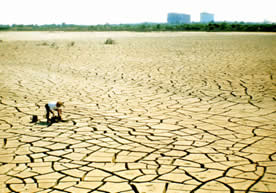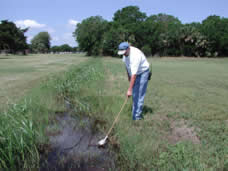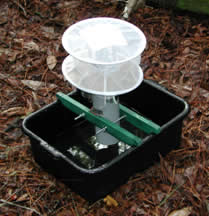Inspections and Surveillance Division
 The Inspections and Surveillance staff is responsible for identifying and monitoring larval and adult mosquito breeding habitats.
The Inspections and Surveillance staff is responsible for identifying and monitoring larval and adult mosquito breeding habitats. Several hundred potential larval mosquito habitats have been identified and are treated with aircraft when necessary. There are at least 93 rain and tidally influenced larval sites on our barrier islands and hammocks totaling over 580 acres, over 6,200 acres of numerous inland, rain influenced, larval habitats, and more than 5,670 acres of dredge material containment areas along the Savannah River. These latter sites are used to contain the water and silt pumped out of the Savannah River to maintain the shipping channel. The total acreage of all our potential larval mosquito aerial targets is more than 12,000 acres. We have never aerially treated all that acreage after any rain or tidal event in our history. A significant weather event typically requires the treatment of 3,000 to 5,000 acres.
 GPS technology is extensively used in our program, and particularly in the surveillance of aerial targets. Each larval site is assigned a unique identification number. Within 24 hours following a rain or tidal event, entomology technicians survey all such sites. First, sites that must be treated by aircraft are inspected. Using the county radio system, they begin the daylong process of calling in the target identification numbers of all aerial sites found to be positive for mosquito larvae. Staff entomologists record these findings, creating an Excel spreadsheet. The size of the smaller targets generally remains constant for each event. Entomology technicians compute the acreage of the larger targets using complex ArcGis® software. At the end of the first day, the total acreage of all larval mosquito aerial targets requiring treatment is known. Pertinent data, such as location of active sites, acreage, larval density, etc. are recorded in tabular form for quick reference by aerial crews while treating.
GPS technology is extensively used in our program, and particularly in the surveillance of aerial targets. Each larval site is assigned a unique identification number. Within 24 hours following a rain or tidal event, entomology technicians survey all such sites. First, sites that must be treated by aircraft are inspected. Using the county radio system, they begin the daylong process of calling in the target identification numbers of all aerial sites found to be positive for mosquito larvae. Staff entomologists record these findings, creating an Excel spreadsheet. The size of the smaller targets generally remains constant for each event. Entomology technicians compute the acreage of the larger targets using complex ArcGis® software. At the end of the first day, the total acreage of all larval mosquito aerial targets requiring treatment is known. Pertinent data, such as location of active sites, acreage, larval density, etc. are recorded in tabular form for quick reference by aerial crews while treating. While the pilots begin larviciding all aerial targets, the entomology technicians return to the field to hand treat the remaining smaller targets, many of which are in or near residential areas. They use various means to control larvae. Mosquito fish are used wherever possible and entomology technicians will restock ponds that have lost their fish during periods of drought. The primary larvicides applied by hand are Golden Bear Oil® (GB 1111), Altosid® Pellets and Altosid® XR Briquets.
While the pilots begin larviciding all aerial targets, the entomology technicians return to the field to hand treat the remaining smaller targets, many of which are in or near residential areas. They use various means to control larvae. Mosquito fish are used wherever possible and entomology technicians will restock ponds that have lost their fish during periods of drought. The primary larvicides applied by hand are Golden Bear Oil® (GB 1111), Altosid® Pellets and Altosid® XR Briquets.Detecting the presence of EEEv and WNv is also an important component of our surveillance program, using sentinel chickens and Centers for Disease Prevention and Control (CDC) miniature light traps. The sentinel chickens are set at six fixed locations for one night each week during the season. After one night in the field, the sentinel chickens are returned to a mosquito-free coop at our facility. A blood sample is taken and analyzed two weeks after the field exposure. Multiple "sets" of chickens are used in the program. After a negative finding, sentinel chickens are put back in the rotation for field surveillance. Individual birds are only used at a single location throughout the season.
Concurrently, CDC traps baited with dry ice are set at all sentinel chicken sites. However, to lessen competition with the sentinel chickens, these traps are positioned five to twenty-five meters away from sentinels. Culiseta melanura and Coquillettidia perturbens from these traps are tested for viral infection. CDC traps are used at additional sites to monitor vector species of EEEv as well as nuisance mosquito species.
 Surveillance for WNv has become an increasingly important aspect of mosquito control throughout the United States in the last several years. Gravid traps (Hausherr's Machine Works, Tom's River, NJ) are set in 28 locations throughout the more urbanized portions of the county. Each of the 28 sites is monitored once per week. These traps are highly effective in capturing Cx. quinquefasciatus, which is the primary vector species of WNv in coastal Georgia. A hay infusion media is used and the traps are set in late afternoon and retrieved the following morning.
Surveillance for WNv has become an increasingly important aspect of mosquito control throughout the United States in the last several years. Gravid traps (Hausherr's Machine Works, Tom's River, NJ) are set in 28 locations throughout the more urbanized portions of the county. Each of the 28 sites is monitored once per week. These traps are highly effective in capturing Cx. quinquefasciatus, which is the primary vector species of WNv in coastal Georgia. A hay infusion media is used and the traps are set in late afternoon and retrieved the following morning.Mosquitoes collected in the CDC or gravid traps are placed on dry ice in coolers in the field and brought to the laboratory where they are identified and sorted on a chill table. Up to 25 mosquitoes are placed in 1.5 ml cryogenic vials and stored at -70°F until they are shipped to the Southeastern Cooperative Wildlife Disease Study in Athens, GA for viral analysis.

 Part of ChathamCountyGA.gov
Part of ChathamCountyGA.gov